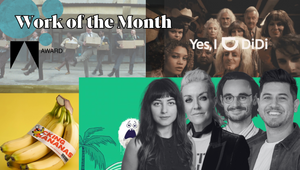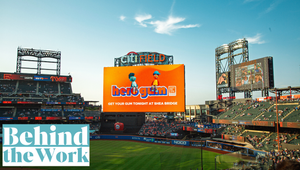
How to Build a Personalisation Strategy Embedded in Creativity

Personalisation allows brands to target people with content that’s relevant for them. But when you’re making content that’s so infinitely flexible, how do you make sure it’s still distinctive, idea-driven and true to the brand?
Speaking to LBB’s Nisna Mahtani about the balance between personalised content and exciting creative concepts are experts from M&C Saatchi London, Havas Media Group UK, Five by Five Global, Wunderman Thompson, Laundry Service, Media.Monks, FCB Global and DDB North America.
Here’s what they had to say.
Josette James
Customer engagement director at M&C Saatchi London
Personalisation is about relevance. The more relevant the message, the more likely the response. However, we are fed thousands of pieces of personalised content online, from Facebook to Amazon to my Sweaty Betty VIP programme, and we don’t pay attention, let alone click on the vast majority of it.
Relevance is necessary but it’s not enough to stand out in a saturated digital world. Elevating relevance into compulsion requires the power of creativity to steal attention. Personalisation is a great way to steal someone’s attention when data and creativity come together to form an uncanny alchemy. Historically the schools of data and creativity have been strangers in the world of marketing, speaking different languages and revelling in ignorance of one another. Yet still, there is a huge difference between data-informed creative strategies from brands like Nike or Spotify, which create thought-provoking creative with personalisation implicit, versus the more obvious automated, devoid-of-emotion online content of the Amazon personalised app experience.
Brands that value creativity highly pair creative with the insightful use of data and media to create customer-centric experiences that drive engagement as much as conversion. Operating models are mid-evolution to create modern data-driven, content hubs. The correct thinking is a longer-term, creative-driven-interactions approach to engagement, not a campaign mentality – ways of working need to be highly adaptable, pacey and transparent. Client-agency teams should operate as one empathetic unit.
With so much to re-learn, has the promised alchemy of data and creativity been achieved? I suspect rather like a JRR Tolkien story, we will see a connected body of tales, fictional histories, invented languages and literary essays about a future world called ‘Creative Personalisation’. But who will be the main characters, what battles will be fought, and will the ending be a victorious one? Who knows, but I will be tuning in for the ride. You coming?
Jack Few
Founder and managing partner at additive+, part of Havas Media Group UK
In paid media, it’s generally accepted that at least 50% of the effectiveness of advertising is based on creative execution, and according to Google studies, it’s closer to 70%. We also know that creative relevance drives engagement, whether that’s in terms of the imagery, copy, audio or other elements. There are many examples where intuitively, this makes sense, for example showing someone a holiday destination that appeals to them specifically, or a car model that suits that individual's lifestyle and requirements.
When personalising content, there is a sweet spot, and there is also a line that brands must not cross, to avoid being too personal. Our job is to establish where that sweet spot is, and it varies for every brand we work with. So, we have developed a litmus test which we apply to all campaigns to ensure we arrive at a strategy that delivers the appropriate level of personalisation and the most meaningful media experience. Ultimately, our job isn't to detract from the big idea, but to build on it in a way that maximises relevance and effectiveness.
Amelia Markham
Senior planner at Five by Five Global
Personalisation presents a big opportunity for brands wanting to create content that’s relevant to their target audience. But, all too often, personalisation is seen as a silver bullet. There’s a suggestion that, if content is personalised according to people’s needs or preferences, then there’s no need for a bigger idea or insight.
Part of the problem is that personalisation is data-driven and digital. It’s left-brain thinking, as System1’s Orlando Wood would say. It’s a logical and reasoned way of approaching advertising, and, he argues, the output is ‘flatter’ and ‘more focused’.
But data doesn’t have to be the enemy of creativity. Data should inform and inspire the creative process rather than restrict it. Practically, this means looking past the numbers. It means trying to understand what the data is telling us, and thinking about how we can use those insights to produce something meaningful and memorable. As marketers, we should aim to create content that’s emotive and entertaining enough to engage our audience, rather than simply serving the right message at the right time.
A simple way to start is to remember that people are receiving and responding to our ads. So we should talk about them as people, not segments. That way, we’re already shifting from left-brain thinking to the much more expansive, empathetic right-brain thinking.
It’s also important to keep the bigger brand idea at the core of communications. After all, relevance is just one part of the picture. Advertising also needs to be easy to recognise and recall if it’s going to work.
Alex Steer
Global chief data officer at Wunderman Thompson
One of the wonders of modern marketing is that you can talk to people as individuals based on a detailed knowledge of them, and still say nothing of interest.
Personalisation is, of course, a tactic not an objective. Nor should we be satisfied merely with the promise of ‘relevance’: if your marketing isn’t relevant, you’re doing it wrong. Personalisation promises that it should let us find ways to be more inspiring: positively motivating people to act, in our favour, because we know something about them that we can use.
Personalisation is prediction. Knowing a lot about someone is not the same as knowing which information to use to increase our odds of inspiring them. The idea that one type of data is the key to personalisation is of course absurd. If I want to sell you a sofa it helps to predict (or know for a fact) what other furniture you might own. If I want to help you improve your health, I want to predict what you value in life and what motivates you. If I want to sell you a cold drink, it matters less that you’re a left-handed introvert and more that you’re in a park on a hot day.
Personalisation is a creative act. Our industry too often talks about it as if it’s a form of engineering. You need technology to enable it in most cases, but having technology does not make you good at being personally inspiring, any more than having hands makes me good at conducting an orchestra. A successful approach to personalisation brings together creative thinking, predictive data analysis and technology design as early as possible. That means creating teams where people with very different skills (and backgrounds, experiences, personality types, etc) are supported to come together as peers. The first question those teams need to answer together is: what would improve the odds that someone is inspired to act in favour of this brand? Knowing what needs to be true is a good first step in working out what needs to be done: how to find the signals of opportunity in data; how to get into the right moments and contexts with technology; and how to make the most impact when we get there.
Personalisation involves learning. If you can know, upfront, all the ways to be as inspiring as possible, you’re much better at marketing than me. Marketing effectiveness is a balance of prior knowledge and experimentation. That’s the other reason to have personalisation as a way of thinking within the main development of marketing activity, not as a bolt-on or afterthought. By engaging everyone in the question of what needs to be true to be more inspiring, you benefit from more prior knowledge, and you find more interesting hypotheses to test through experimentation.
Lastly, personalisation should leap not creep. When the data and technology side is kept at a distance from the creative side, you end up using all your analytical firepower to test tiny variations and improvements. It’s little surprise, then, that the differences between best and worst performing approaches end up marginal. Throw creativity into the optimisation process: balance many small changes with a few big ones. Analysts call this ‘overcoming local maxima in optimisation’; creatives call it ‘trying something new to see if it’s better’.
It should be obvious that the secret to success is no secret. It’s the right combination of creative, data and technology skills - together, from the start, as equals. It takes leadership, discipline and patience to create effective cultures that can do this kind of work. It’s a team sport in a long game.
Brad Jones
Group creative director at Laundry Service
Most Americans are exposed to between 4,000 and 10,000 ads every day. As creatives and strategists, we’re constantly reinventing our playbook for how we connect with people and focus their attention. To stand out, we must stay relevant. Case in point: 81% of Americans text regularly. Why? It’s considered more personal than dropping into somebody’s DMs and less formal than an email.
As Laundry Service is the social AOR for Amazon Prime Video’s Action, Horror and Thriller genre team, we were tasked to launch season two of The Wilds. The show follows a group of diverse teenagers who get stranded on a remote island and soon realise that they’re the subject of a grand social experiment. In one of the final episodes in season one, a mysterious phone number shows up on a hoodie washed up on the beach. We knew we had to do something with that. We wanted to blur the lines between the plot and how our fans interact in real life.
We partnered with technology platform, Community, to activate the phone number, inviting fans to text directly with one of the characters from the show: the experiment’s mastermind, Dr. Gretchen Klein. Our creatives and social media managers collaborated with our partners at Amazon Prime Video and the show's EPs to engage directly with fans throughout the launch with exclusive content and personalised messages written in the voice of Dr. Klein in real-time – making them feel like they were part of the story as it unfolded. During a time when content is required to be infinitely flexible, personalisation is a powerful tool to connect with new audiences – but never at the expense of the big idea.
Jon Biggs & Nimo Awil
Executive creative director and creative director at Media.Monks
Jon> As we’re constantly being told - people’s interests have changed from products to experiences. Momentology shared that more than 79% of US consumers expect personalised experiences from brands. And personalisation is a powerful feature of a great customer experience. But, as an industry we’ve turned personalisation into targeting and even worse - retargeting. And no one wants to be a ‘target’. After you’ve been chased all over the internet by those sneakers you looked at once - you can see why people install ad-blockers.
How do we make it work? We’ve become a little transfixed by the technology itself, and we’ve forgotten that the success of communication still lies in the basics of attention, communication, and persuasion. If we apply our craft skills to create personalised ads that are interesting, then we can make content that feels less throw-away and more of an effective part of the great customer experience we’re aiming for.
Nimo> Let’s also not forget that we need to remind ourselves where the term ‘personalisation’ even came from - a person. Every person has a story, a life and a past that we as advertisers can never truly know from data, so we hold that in our minds. As creatives and storytellers, we can help brands find a place within personalisation that makes sense, without treating their consumers as data points.
Stories and oratory history have always been about communicating with intent and authenticity. It’s a challenge to show up in original and authentic ways nowadays for obvious reasons. I guess the wake-up call is humility and action is empathy baked into the creative process.
Rosie Gentile
EVP, FCB/SIX practice lead at FCB Global
At FCB, we believe in the power of creativity as an economic multiplier. Good creative can build brands and drive performance – this is what we refer to as ‘the power of and’. This is also why FCB/SIX does not live separately from FCB. Instead, FCB/SIX is embedded in all our offices.
I’d like to take a moment to be provocative and say this: as an industry, we’ve barely scratched the surface of the power of true personalisation. Our entire industry is being seduced by the technology and its capabilities, and we’re losing focus on the brand and consumer.
Personalisation is not about modified luggage. It’s not about taking a piece of content and adding a ‘personalised’ salutation or making a visual or copy change. It’s not about the volume of assets you can dynamically generate or the creative versions you can create. It’s not about tinkering to see if you can get a slight lift in performance or a slight improvement in your return on marketing spend.
What personalisation is about is understanding your audience and driving resonance through brand relevance and distinctiveness. Our approach toward modern performance marketing is to stop thinking of our audience as segments and to continue thinking of them as humans. FCB/SIX humanizes the data to fuel creative thinking. Beyond just demographics, we dig into who our audiences truly are – their motivations, needs, and importance – and we dig into what’s currently happening in culture. We then think about how the brand can unlock value for the consumer and breakthrough. Sometimes it’s more of a 1:any or 1:few approach and other times it may be a 1:1 approach, but no matter what, the approach is always grounded in the brand and consumer insights.
Here’s why a better approach is needed today:
- Consumer expectations are higher. They want better experiences and value in exchange for their data.
- Advertising costs are rising. We need to minimize media waste and duplication.
- Client investments in mar/adtech are heavy. We need to better qualify customers to help drive conversions and LTV, and we can’t just generate leads and clicks.
Yes, personalisation works. But, as an industry, let’s stop tinkering and focusing on what the technology can do and instead focus on creativity, customer-first approaches and making more distinctive brand experiences.
Pradeep Kumar
Chief data officer at DDB North America
While personalised marketing has the potential to reach specific audiences in more relevant ways, it doesn't eliminate the need for brands to reach all present and future buyers of the category. What does the audience focus on? Our audience are choosers. Making the right brand choice is their focus. They learn from brand actions or brand behaviour, and brands in turn must learn from audience behaviour. Brand building and personalisation – they work together, and they are most effective when it’s a two-way street, a dialog.
People’s expectations of brands are evolving. There is a growing demand for both personalized and shared experiences. Brands must innovate, adapt, and respond to consumer actions, feedback and evolving needs and unmet wants. Being true to brand means holding on to a value system catering to the unchanged, everlasting human truths as well as elevating the brand proposition to recognize and evolve as the category and the environment changes. Brands must stay relevant and keep adding value.
The opportunity is to reimagine commercial success by championing creativity from the first mile to the last mile. Creativity is not confined to image and consistency. An ecosystem that stifles creativity and experimentation curbs commercial growth. Earning and building trust is critical. Beyond consistent, championing creativity through coherent content and experiences is the impactful way to grow brands.
Here are some of our principles in personalisation with creativity at the heart of it:
- Full funnel personalisation: The creative opportunity is to practice full funnel personalisation. It is not that we personalise everything at every stage. It is about a good balance of time lasting stories and timely, relevant content to strengthen positive brand reputation in the long term and accelerated business results along the way.
- Moment engineering: Recruitment and retention of consumers, both are important to brand growth. Identifying ownable moments and right to win moments and creatively addressing them help in personalisation. Having coherent jobs to be done at these moments is important for the brand to be distinctive.
- Data is the compass: Use data to identify uncommon, insightful patterns and address them creatively. Revamp data competency and apply data and creativity to tangible business outcomes. Bridge insights-to-action gap with interdisciplinary skillsets. At the same time, permission creative bravery.
- Creative operating system: Build an agile, reimagined creative operating system that ensures building distinctive brand assets, addressability as well as adaptive content and experiences. This warrants creativity in defining and describing growth audiences, identifying 'phygital signals' and ensuring tailored content and experiences that work in emerging media, spaces, and marketplaces.
- Experimentation: Before embarking on a personalisation strategy, always question if it is needed, possible and worth it. While creativity remains at the heart of it, let creativity plus experimentation drive personalisation. It is imperative to design a learning agenda and decipher the signals from the noise.















